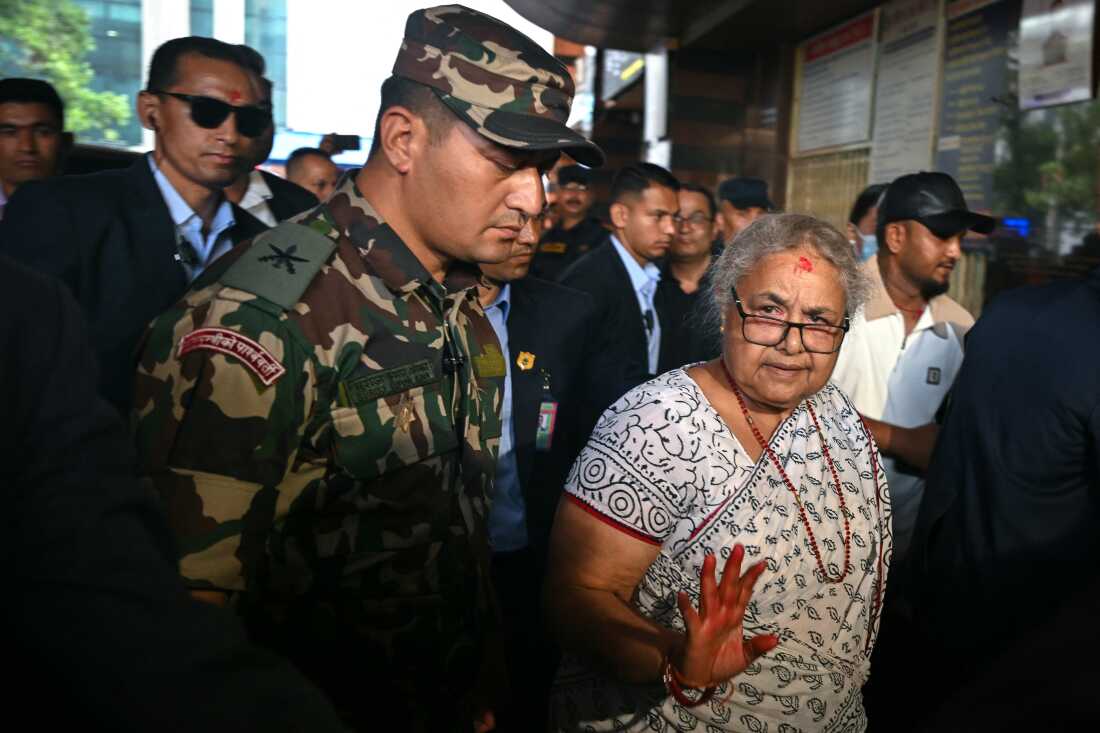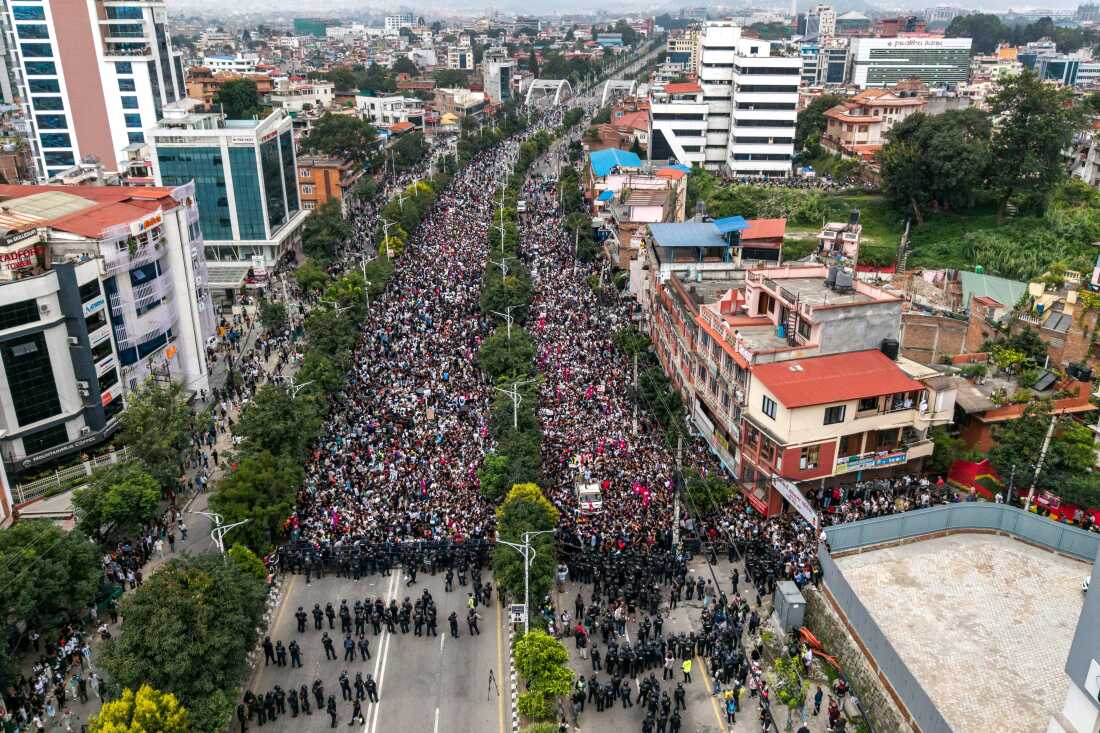Individuals mild candles beside the phrases studying “Long live martyrs” throughout a silent tribute observing a nationwide day of mourning in honor of these killed in clashes throughout current protests, in Kathmandu, Nepal, on Wednesday.
Arun Sankar/AFP through Getty Photographs
conceal caption
toggle caption
Arun Sankar/AFP through Getty Photographs
KATHMANDU, Nepal — The Nepal Parliament constructing is a placing mixture of previous and new: a sprawling construction of metal and concrete capped off by a two-tier pagoda. However final week, its white partitions have been coated in soot and graffiti. “You picked the wrong fight,” reads one message, signed: “Gen Z.”
It is the fallout of probably the most dramatic upheaval the Himalayan nation has skilled in years — the place in lower than 48 hours, protesters compelled the overthrow of the federal government.
Nepal’s authorities is simply the most recent in South Asia to be overthrown by protesters, and it underscores the profound generational change shaking the world’s most populous area and testing governments’ means to fulfill their residents’ expectations.
The turmoil in Nepal started in earnest on Sept. 8, when police within the capital Kathmandu opened hearth on anti-corruption protesters as they tried to breach Parliament partitions. Mobs retaliated by torching buildings, looting banks and retailers, and attacking politicians of their houses. The violence killed greater than 70 individuals and wounded 1000’s extra, in keeping with Nepal police spokesperson Ramesh Thapa.

Hearth rages by way of the Singha Durbar, the principle administrative constructing for the Nepal authorities, in Kathmandu, on Sept. 9, a day after a police crackdown on demonstrations over social media prohibitions and corruption.
Prabin Ranabhat/AFP through Getty Photographs
conceal caption
toggle caption
Prabin Ranabhat/AFP through Getty Photographs
Prime Minister Khadga Prasad Oli resigned on Sept. 9 and has not been seen publicly since. The military imposed a curfew.
By Sept. 12, the nation had a brand new interim chief: Sushila Karki. The 73-year-old was Nepal’s first feminine chief justice — and is now its first feminine prime minister. Her appointment by Nepal’s president adopted on-line polls on the chat portal Discord, the place 1000’s supported her citing her judicial document of taking up the corrupt and the elite.

Prime minister of Nepal’s interim authorities, Sushila Karki (entrance proper), arrives on the Nationwide Trauma Heart hospital to go to victims injured in clashes with safety personnel, in Kathmandu, on Sept. 13.
Arun Sankar/AFP through Getty Photographs
conceal caption
toggle caption
Arun Sankar/AFP through Getty Photographs
“Our movement was motivated by two things,” says Abhiyan Sapkota, a 27-year-old civil engineer who participated within the protests, “unemployment and government corruption.”
For months, younger Nepalis sought to focus on the gorgeous distinction between the nation’s plenty and its rich elites, pulling collectively montages of social media photos and movies uploaded by the kids of distinguished politicians. One picture confirmed a younger girl posing with a Prada bag value $2,600, in a rustic the place the typical yearly earnings in Nepal is lower than $1,500 a 12 months.
They zoomed in on Nepali elites vacationing in Europe, a distinction to the travels of most residents — who work overseas in low-paying jobs as porters, troopers and development staff.
The marketing campaign, utilizing variations of hashtags like #NepoKids, got here amid mounting frustration with politicians who’re broadly seen as utilizing public cash to enrich themselves. “Over the last 10 years, all three individuals who have traded the prime minister’s chair have had pretty serious corruption allegations against them,” says Ashish Pradhan, an skilled on Nepal on the Worldwide Disaster Group, a suppose tank.
Investigators by no means pursued the instances significantly, he says. “Instead, the anti-corruption watchdog was used to go after political opponents rather than to tackle systemic misuse of funds.”
However on Sept. 4, the federal government abruptly suspended most social media. It was broadly seen by anti-corruption activists as an try to quell their marketing campaign exposing the poolside luxurious lives of Nepal’s elite. That led to 1000’s protesting in Kathmandu on Sept. 8.

An aerial view exhibits demonstrators gathered outdoors Nepal’s Parliament throughout a protest in Kathmandu on Sept. 8.
Prabin Ranabhat/AFP through Getty Photographs
conceal caption
toggle caption
Prabin Ranabhat/AFP through Getty Photographs
Within the days after violence, military personnel fanned out throughout the nation. On main roads of Kathmandu, they arrange checkpoints each few hundred yards and checked IDs. When curfew was relaxed for just a few hours day-after-day, youths cleaned the streets, visited hospitals to test upon the injured and held candlelight vigils for protesters who’d misplaced their lives. Outdoors a burnt-down police station in Kathmandu’s Darbar Marg, somebody scrawled an apology: “Sorry dada,” Nepali for an elder brother.

A demonstrator shouts slogans throughout a protest outdoors the Parliament in Kathmandu on Sept. 8.
Prabin Ranabhat/AFP through Getty Photographs
conceal caption
toggle caption
Prabin Ranabhat/AFP through Getty Photographs
The assaults on mainstream political events additionally prompted introspection amongst some cadres.
Nepal has seen over a dozen coalition governments up to now twenty years. However the high workplace has largely rotated among the many similar set of leaders, most of them of their 70s. Now, some are demanding a change in management. Pratima Gautam, member of the Nepali Congress celebration’s central working committee, says the protesters had a message for the previous guard: “Step back a little.”
The rebellion has come at a time of revolutionary fervor throughout South Asia.
“There are certainly some common threads between what we’ve seen in Nepal in the last week and what we seen in recent years in South Asian other countries, like Sri Lanka and Bangladesh, especially with cases of elite, long-standing regimes being deposed after crises that involved level of economic pressures that were being felt by citizens,” says Pradhan, of the Worldwide Disaster Group.
The youth, he says, have been spurred by rising prices of residing and inflation, and reeling from the affect of local weather change and COVID-19 lockdowns. Pradhan says the governments used power as a result of they thought they may get away with it.
“The kind of international order and the checks and balances that were there in the glory days of the 1990s and parts of the 2000s have slowly eroded over time. The global picture now resembles a little bit more of a wild, wild west where might is right, and force and transactional diplomacy and mercantilism rule the day,” he says.

Nepal’s newly appointed interim prime minister, Sushila Karki, together with officers, observes a second of silence for the individuals who died in current protests, on Sept. 14.
Prabin Ranabhat/AFP through Getty Photographs
conceal caption
toggle caption
Prabin Ranabhat/AFP through Getty Photographs
Nepal is scheduled to carry elections early subsequent 12 months. Analysts say the problem in entrance of the interim authorities is to take care of order and chorus from politics of retribution.
There’s optimism among the many youth. When the interim chief took an oath every week in the past, many defied curfew to sing and have fun on the streets. The favored Instagram account Genz.Nepal summarized it in a pithy publish: “PM Sushila Karki… SLAYYY 💅🏼.” The slang is a praise.
However long-time Nepal watchers advise warning.
Political analyst Chandradev Bhatta says Nepal has a protracted historical past of regime-change by way of avenue protests. The nationwide authorities has modified palms greater than a dozen occasions within the final decade.
The instability has usually been a results of tensions between democrats, monarchists, the Maoists and political events. “If it was happening for the first time, I wouldn’t have minded because we needed the change. But we’ve written seven constitutions in more than 70 years,” Bhatta says.







